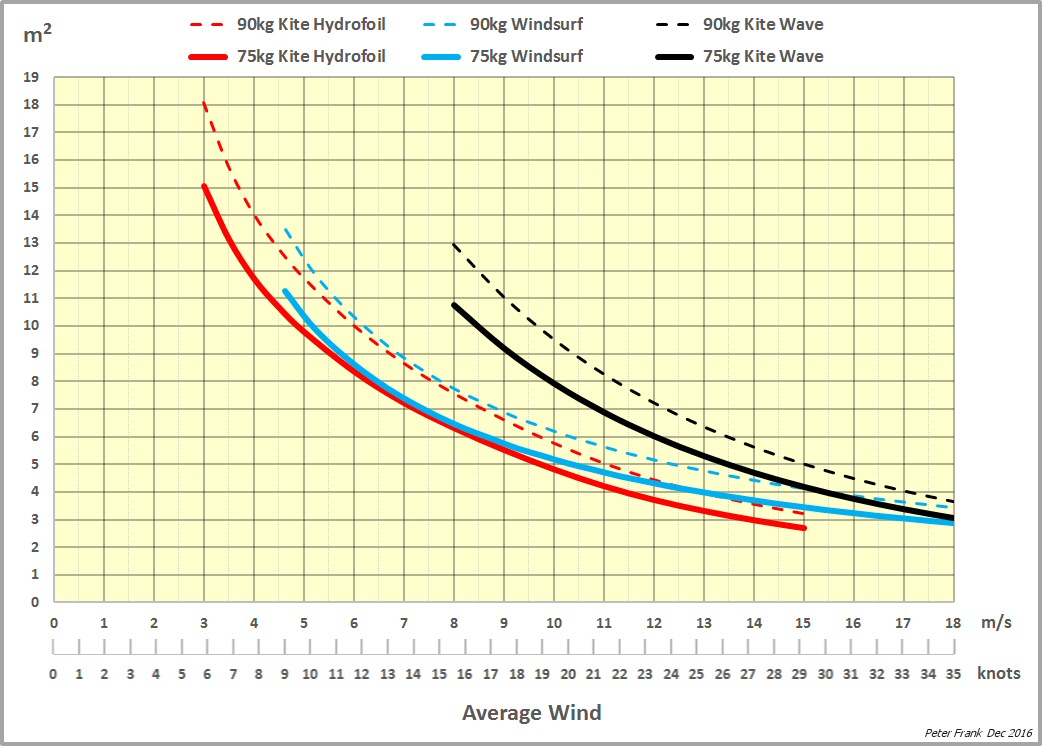I have known for a while which sizes I use in which average winds, both when on a waveboard, and a hydrofoil freestyle/freeride/waveriding, and what I rode and my friends ride windsurfing.
Have puzzled with the calculations, to get the physics to fit the real world - and reversed, it actually helps to know what to use when A LOT of wind, above the usual comfort zone maybe
So these are my chosen sizes, taken everything into account, using bigger and bigger wings when wind close to 10 knots and below, and longer lines.
The important thing is, that in really low wind less than 7 knots, your apparent wind comes so much from the front, that the kitelift is mostly sideways, thus extremely inefficient and higher drag from the hydrofoil too when all vectors taken into account - and this is why we can not just use a 40m2 kite in almost no wind, as the power get "pinched" away from us so to speak
Anyways, these are my "sweet spot" sizes I choose in LEI units:

For a race foilkite you can multiply approximately by 1.3 I would say, meaning an 11m2 race foilkite has equivalent power to a bit over a 14m2 LEI kite, because of its higher projected area and less drag and higher efficiency so a better lift angle in low wind.
Yes, they also have more depower so can be held in much more wind too, but thats beyond the point about the sweetspot for freeride/freestyle.
I am 77kg, but have added the equivalent simply scaled up, for 90kg.
Of course everybody will now say this is not correct (for them), but it fits the bill regarding physics and it fits me spot on, so to some extent you should be able to just offset up if you ride with more power, even if not heavier.
Or if upwind/downwind current you also offset a tad.
I ride the same kitesizes as similar weight wave/surfboard riders here, but many are heavier than 75kg so ride one size bigger than me.
On hydrofoils I ride relatively small compared to some, but it fits sweetspot for playing in the waves.
I have left TT sizing out - as we hardly see any on TT's nomore, at least never when out at wavespots, and not many or any riding waveboards and hydrofoils ride TT's.
For the windsurf sail sizes, it is taken into account you ride on a formula board when close to 10 knots, a smaller slalom/freestyle board when above, and a waveboard/wavesail when 18-20 knots and above.
Rant on, as I know most of you most likely will now, but hey - maybe a few can use it too ?
Plummet, you asked me if I never jumped when riding on a waveboard ?
YES, it is my sweet spots, so I am fully powered going upwind fast, and jumping perfectly.
Most riders overestimate the wind, for different reasons - if they measure themeselves, they always mentally memorize the highest numbers they see on their meter.
And for standard weather stations positioned at the shoreline, f.ex at a yacht club, if wind is a bit onshore it accelerates over the buildings and coastline, or if sideshore it accelerates over the pier, so more wind than true average free flow wind.
Meters on wind power stations show too much usually, as too high up - but one will know how much they are off, after many years of course.
The opposite can also happen, that the wind gets slowed down when meeting the coast and high obstacles - so it goes both ways.
My point is, it is really difficult to measure the wind correctly, and most often we focus on the max winds we see eventhough not a correct average wind
Why have I gone through all this trouble setting the principles and physics and calculating this, correlated with real life sizing ?
Because I love and live for wind and planes/gliders and sailing/surf - so a basic part of my life since I was 10, and both interesting and in some instances valuable to know the ways everything interacts - so I can not help it, great to see it can be explained, eventhough you just most often KNOW which size to choose when standing on the beach, I know
The most valuable benefit for me, is that if out on a waveboard with a given kitesize, and I want to go on a hydrofoil, or reverse, I know exactly what size to rig down/up to without any risk of choosing wrongly.
Or if out with others on a different type of board, could be windsurfers, I have an idea how much wind is far out on the break seeing which sizes they use (and you know how heavy they are, if you know almost everybody).
This can be impossible to know in many spots and pure luck whether you choose the right size or not, if the wind is sideshore and the break REALLY far away
